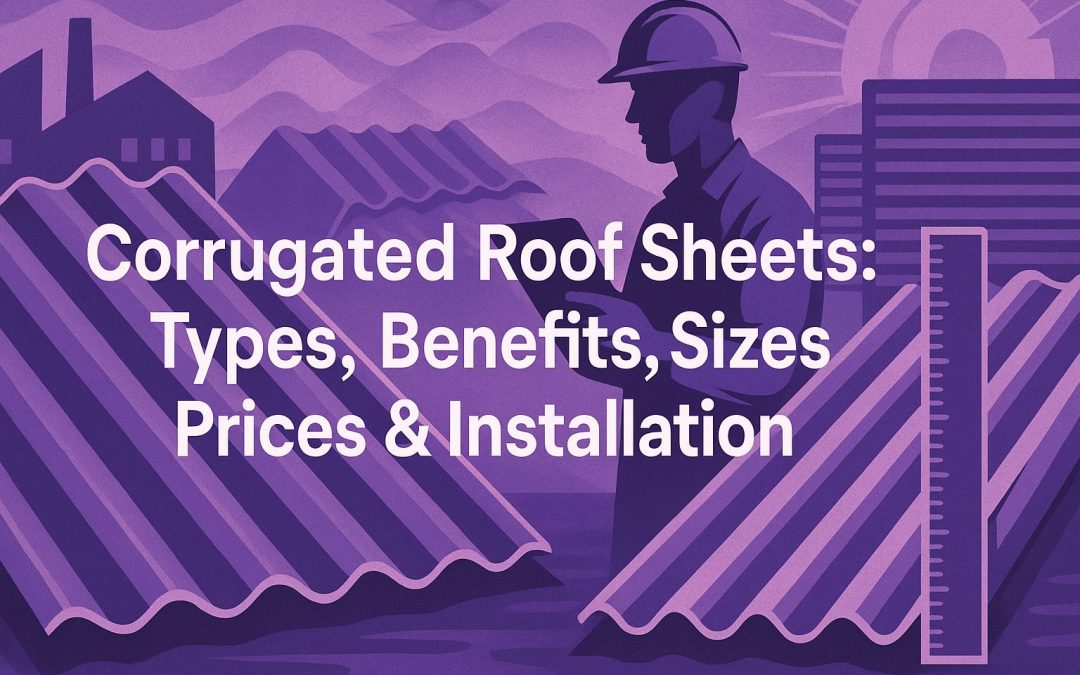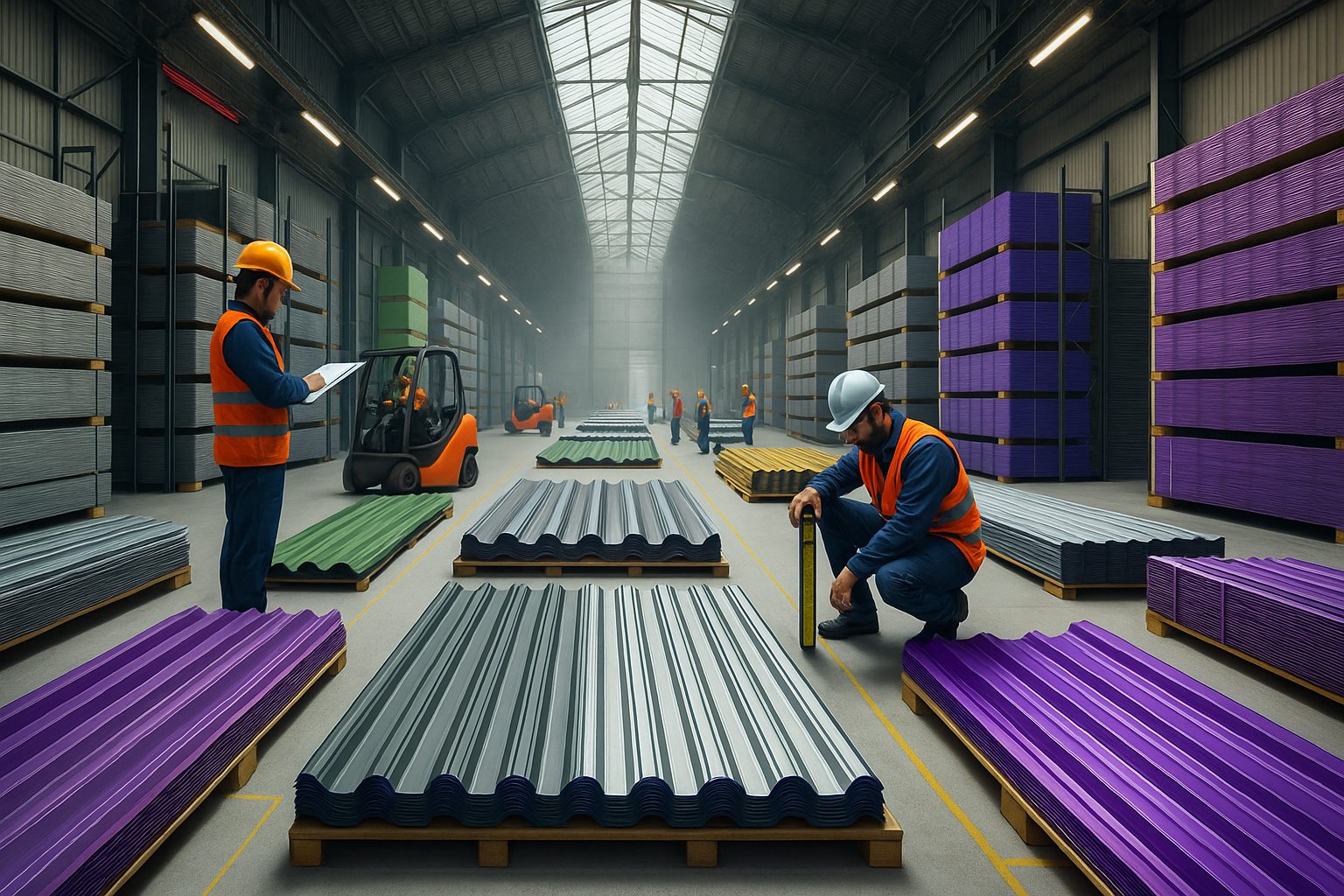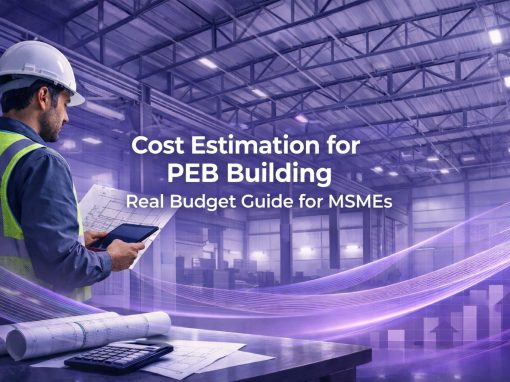Table of Contents
There has been a significant shift in the Indian roofing industry from conventional options like tiles to more value-for-money steel roofing solutions. The growth in industrial applications is a major cause for the same. This shift has created a huge demand for different kinds of steel sheets for protecting the roof in domestic, commercial, and industrial institutions. One of the best options that is available in the market is corrugated roof sheets – distinguished by its unique wavy design and its versatile uses.
What is Corrugated Roof Sheet?
Corrugated roof sheets are popular roofing solutions and can be distinguished by the repetitive folds on their surface. The unique shape of the sheets offers years of reliable utility and greater strength. They can be made from different metals – steel, tin etc. that gives them its robustness.
Corrugated roof sheets manufacturing involves a process where the metal is rolled into a wave like pattern for structural strength and ability to resist weather and mechanical impacts. The corrugated design on the sheets with ridges and grooves make them stronger and durable.
As a builder, when selecting a corrugated roof sheet check its types, size and specifications.
- Galvanised steel sheet usually forms the base for most types of corrugated sheets. It is usually coated by polyester paint or protected by PVC Plastisol and offers excellent resistance to corrosion and harsh weather.
- Polyester painted sheets are usually used in agricultural buildings for its medium-length lifespan and economic efficiency.
- PVC Plastisol coated corrugated sheets comprise steel sheets treated with primer paint and PVC rolled on their surface. These roofing sheets are very durable lasting for around 25-30 years.
Corrugated sheet thickness
These roofing sheets are available in 3 gauges – 0.42, 0.48 and 0.60. While 0.42BMT is used mainly for domestic roofing, the 0.48BMT is more popular for commercial applications. Out of the three 0.60BMT is the heaviest and strongest of all.
Corrugated roofing sheet prices by foot size 2025
When you are buying corrugated roofing sheets, prices are often based on sheet size or weight. It is usually in square feet, square feet, square meters, or per kilogram. In 2025, most sheets continue to cost around ₹250–₹500 per sq. m., depending on thickness and coating. However, prices remain steady, supported by domestic supply.
Apart from it, costs may vary by length, width, thickness (BMT), and whether the sheet is galvanised or colour-coated. To help you estimate your budgets more accurately, have a look at a quick comparison of the latest prices by popular foot size that today’s buyers typically pay:
| Size (ft) | Sheet type/ Finish | Approx. price (₹/sq.ft.) |
| 6 × 3 | Galvanized standard corrugated | ₹70–90 |
| 8 × 4 | High-rib corrugated | ₹100–120 |
| 8 × 4 | Colour-coated corrugated | ₹120–150 |
| NA | Corrugated steel (unsized listings) | ₹37 |
| NA | PPGI (pre-painted GI) corrugated | ₹30 |
| 12 × 4 | Corrugated GI (heavy gauge, transparent) | ₹110/ft² |
What are the benefits of corrugated sheets?
Corrugated steel roofing sheets are now a popular option for many businesses and private homeowners. The five major benefits of using corrugated metal roof sheets and why they make a better option are given below:
- Prevents water build up: Due to the unique shape, corrugated roof sheets help water run downwards and keeps your roof top clear.
- Durable: A corrugated roof sheet that is made from metals like steel or aluminium lasts for years and needs very little maintenance apart from a coat of paint occasionally.
- Lightweight: Apart from being durable, these sheets are also lightweight making it easier to handle and install. It also does not increase the weight of the building structure.
- Withstand weather conditions: Equipped to survive all weather conditions, corrugated sheets provide a protective barrier to your establishments and never rusts.
- Rot resistant: Unlike most roofing material, corrugated metal roof sheets do not rot. Most metal sheets are also protected with a layer of chemicals to stop the formation of algae.
Also read: Corrugated metal pipe – Sizes, prices, manufacturing process
Why use corrugated roofing?
So why should you used corrugated metal roofing sheets? As we have seen in the previous section, these roofing sheets offer distinct advantages that makes them the preferred choice in industrial and residential construction projects.
- Durable and long lasting
- Corrosion resistant (metal specific) and robust to withstand extreme weather conditions (Also read: Steel corrosion)
- Lightweight and easy to install
- Cost-effective in the long run
- Reduces cooling costs in buildings
We’ve prepared a comparison between regular roofing sheets and corrugated metal roofing sheets for you to evaluate the benefits:
| Feature | Regular metal roofing sheets | Corrugated metal roofing sheets |
| Structural integrity | Lesser strength | Higher strength and durability due to corrugation (ridges) |
| Aesthetic properties | Limited styling as these are regular sheets | Diverse style, design and finish available based on choice of metal |
| Weather resistance | Less resistant to harsh weather, atmospheric moisture, and other environmental hazards | More resistant to harsh weather conditions, especially resistance to corrosion, rust, heavy rains, and heating (cooling effect) |
IBR vs Corrugated Roofing: Key Differences
Along with regular metal sheets, these days buyers also compare IBR (Inverted Box Rib) sheets with corrugated sheets. Corrugated roofing sheets are widely used due to its affordability, but these buyers also choose IBR sheets for enhanced strength, better water management, longer lifespan, amazing aesthetics and more.
Though, if you are looking for more classy look then choose corrugated sheets for instance farm sheds, basic structures, etc. Let’s have a quick comparison to help you choose the right profile for your project:
| Feature | Corrugated Sheets | IBR Sheets |
| Profile | Wavy (S-rib shaped) design, traditional or classic look | Square/trapezoidal ribs, modern appearance |
| Strength | Strong but less rigid | Higher rigidity, longer spans |
| Water Drainage | Needs steeper slopes to avoid leakage | Allows faster runoff, works on low-slope roofs |
| Aesthetics | Classic, rustic appeal | Sleek, contemporary look |
| Cost | More economical, budget-friendly | Slightly higher cost, durable with less maintenance |
What are the sizes of corrugated roof sheets?
Corrugated steel roofing sheets are one of the most popular roofing solutions and they come in various sizes that builders and business owners can secure based on their requirements. The flexibility in corrugated roof sheet sizes helps address different construction and architectural needs, balancing functionality with aesthetic appeal.
Corrugated steel roofing sheets sizes and application
| Size type | Length (in meters) | Application |
| Small | 1.8 m – 3.5 m | Small sheds, garages |
| Medium | 4 m – 10.0 m | Residential house roofing, small factory workshops |
| Large | 12.0 m – 20.0 m | Industrial warehouses, large sheds |
*For reference only. Please check with your steel supplier for actual sizes and dimensions.
From small residential projects to industrial applications, it’s important to use corrugated roof sheet sizes accurately for efficient coverage and fewer seams.
In India, due to storage and transportation issues, most steel suppliers and distributors will stock corrugated roofing sheet sizes across 2 m, 2.1 m, 2.7 m, 3 m, 4 m, 5 m, 6 m and 8 m. For larger sheets or special sizes, check with the manufacturer.
Also read: Sheet bending machines – Understand how steel sheets are bent into different shapes and sizes
What are the types of corrugated roofing sheets?
Corrugated root sheets provide an environment-friendly option to businesses to use as roofing solutions. There are several types of corrugated sheets that you can choose from. The four types are highlighted below:
- Galvanised steel sheet: A carbon steel sheet coated with zinc, these corrugated sheets can either be used bare or painted.
- Polyester painted sheets: Mostly used for agricultural structures, these sheets need to be maintained every five or ten years.
- PVC Plastisol: A steel sheet that is treated with a steel primer paint and rolled in PVC, this type of sheets is used for its durability and is expected to last up to 30 years.
- Bitumen: These corrugated roofing sheets are made from bitumen. It is waterproof, long-lasting, and highly durable.
What is the best type of corrugated roofing?
Corrugated metal roofing sheets can be manufactured from different materials/metals. Popularly used materials for corrugated roof sheets are: bitumen, PVC, polycarbonate and metals such as tin, aluminium, and steel (galvanised and stainless steel).
Popular corrugated metal roofing sheets example and applications:
| Metal type | Benefits/Features | Applications |
| Corrugated steel roofing sheets | Affordable, strong, and easily available | Industrial and storage facilities |
| Corrugated galvanised steel roofing sheets | Durable, rust-resistant, slightly expensive | Warehouses, industrial buildings |
| Corrugated stainless steel roofing sheets | Expensive, corrosion-resistant, long-lasting, aesthetically appealing | High end buildings, commercial structures |
| Corrugated tin roofing sheets | Moderately resistant, lightweight, economical | Temporary setups, small structures |
| Corrugated aluminium roofing sheets | Lightweight, highly corrosion resistant | Residential structures/houses, coastal and marine environment |
As can be understood, the best corrugated roofing sheet type depends on the structure being built and the environment it is being constructed in. Galvanised steel corrugated roof sheets however stands out in India due to its strength, durability, cost-effectiveness and rust resistant properties.
Also read: Tips to reduce steel corrosion
How to install corrugated roofing sheets?
Installing a corrugated roof sheet is a straightforward process. Let’s take a look at it with an example. You can use corrugated steel roofing sheets or corrugated tin roofing sheets or any other, but the steps remain the same.
Steps to install corrugated roofing sheets:
Imagine installing a corrugated steel roofing sheet on a residential garage in a city (e.g., Chennai). The structure will be exposed to heavy rains and harsh weather (heat) and requires a robust, waterproof, and cooling roofing solution.
Step 1:
Prepare the roof frame by clearing any debris or old roofing material. Ensure it is sturdy and clean.
Step 2:
Measure the roof and cut the sheets to size. For instance, if the roof is 12×8 feet, you will need approximately 6 steel roof sheets, each measuring 4 feet in length.
Step 3:
Begin laying the sheets from the bottom left corner of the roof. Ensure each sheet overlaps the previous one by approximately 2-3 inches.
Step 4:
Secure the sheets using steel nuts and bolts, screws and nails. Ensure the sheets are strongly attached to the rafters. Maintain small spaces between the fasteners/screws, roughly 4 to 6 inches.
Step 5:
Seal any gaps between the overlapping sheets by applying a high-grade sealant to prevent leaks.
Step 6:
Complete the installation by fitting a ridge cap across the top of the roof. This will give it complete coverage, enhance its waterproofing capabilities and structural integrity.
How much should corrugated roofing sheets overlap?
Proper overlapping of the corrugated metal roofing sheets is important to ensure there is no water leaking and for its longevity. Typically, an overlap of at least 2 corrugations between sheets is recommended.
We’ve compared different scenarios to explain the guidelines:
- Residential garages: For a standard garage with a flat slope roof, basic overlap of 2 corrugations is sufficient to ensure there is no leakage through the joints
- Industrial warehouses: Since the roof span wider areas in large structures, an extra coverage overlap of 15 to 24 inches is recommended, to withstand large volumes of water
- Agricultural buildings: Here too, a basic 2 inch overlap will work, especially for small barns and agricultural settings, though it is recommended to add an additional layer of sealant for waterproofing
How to cut corrugated polycarbonate roofing sheets?
To cut corrugated polycarbonate roofing sheets you must take care to be precise in measurements to keep the installation safe. Follow the steps below:
- Measure the dimensions precisely and make markings on the sheet for accurate cutting
- Use suitable tools for cutting polycarbonate roofs such as a circular saw
- Clamp the sheet to a stable structure during cutting to prevent dislocation and movement
- Cut along the marking slowly and continuously to avoid chipping
As a safety measure, always ensure to wear proper gear when cutting sheets, check the sharpness of the blade to avoid jagged edges, and use support equipment to keep the sheets stable.
Also read: Cladding sheets – Learn how wall cladding sheets are used
How to lay corrugated roof sheets?
We saw during the corrugated steel roof sheet installation process why it is important to lay the sheets correctly. Here are the steps to lay corrugated roof sheets:
- Begin installing the sheets from the bottom left side
- Ensure to overlap sheets by at least 2 corrugations to prevent leaks and seepage
- Use steel fasteners and screws to securely fasten the sheet joints to the rafters
- Apply sealant or rubber washers to provide further protection
Before you begin to lay the corrugated metal roofing sheets, ensure that you have the sheets cut precisely as per required dimensions, wear safety gloves, glasses and other gears, and use walk boards to walk.
How to fit corrugated roof sheets?
To ensure structural safety and durability, it is essential that you fit the corrugated roof sheets correctly. Here are the steps to help you with it:
- Begin by positioning the first sheet correctly at the bottom end of the roof
- Place the next sheet over it (ensure at least 2 corrugations between them)
- Use screws and nuts to securely fasten the sheets at the joints
- Apply sealant if required to provide additional waterproofing based on the environmental conditions
During the fitting stage ensure the sheets are aligned straight (use chalk lines if required), wear the required safety gear, and do not over tighten at the joints as it may warp and damage the sheets.
Conclusion
Roofing is one of those decisions builders rarely take lightly, and corrugated sheets have earned their place because they solve more problems than they create. In India, where roofs must stand up to heavy monsoon rain, blistering summers, and often less-than-perfect installation conditions, the simple corrugated profile still performs. Buyers usually weigh galvanised against colour-coated or polycarbonate, but whichever way you go, the logic is the same — strong sheets, fewer leaks, less upkeep.
Yes, they cost a bit more than tiles or asbestos at the start, but anyone who has maintained a warehouse or shed will tell you the math balances out. A good sheet, cut to size, installed with proper overlap and ISI compliance, can last decades. For small contractors and MSMEs, that reliability is worth more than the saving of a few rupees at purchase. In the end, corrugated roofing remains a practical choice — not glamorous, but trusted, and still the roof most Indian businesses fall back on.
Looking to procure steel?
Tata nexarc helps manufacturers, builders and MSMEs source certified steel products, compare prices, and choose the right grade as per IS codes—with complete traceability and procurement confidence.









